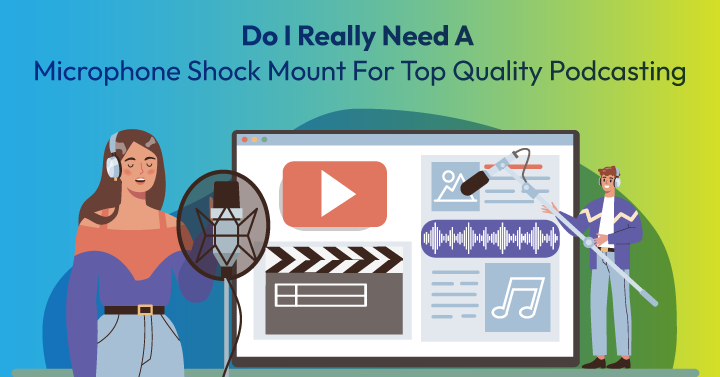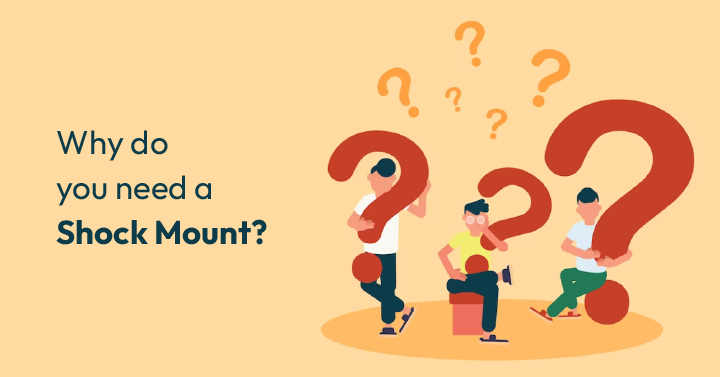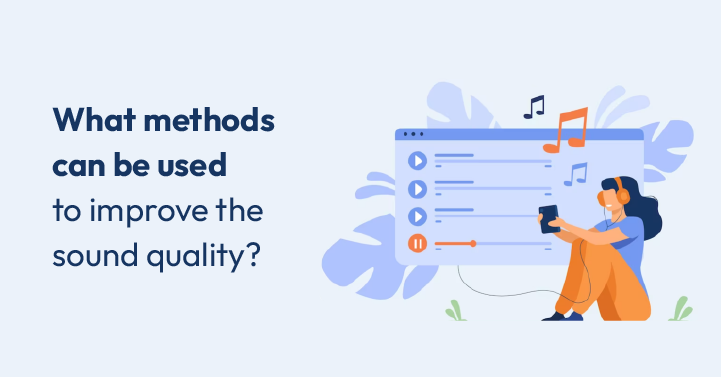
Mic shock mounts are innately helpful to boost the quality of your podcasts. In fact, most podcasters use a universal microphone shock mount to produce crisp, clear audio sections without those pesky white noises. But the question is – do I need a microphone shock mount for podcasting? What does a microphone shock mount do for me? If you’re a newbie podder, this may be a tricky decision.
And that is exactly why we’ve gone ahead to put together this quick read that answers the inherent question – do you need a shock mount? We’ll also be covering types of them, including the very popular universal microphone shock mount, so stick with us to the end!
1. What is a Microphone Shock Mount?
Shock mounts are an accessory to your microphone to help reduce intrusive, unwanted sounds on your final output. These things are commonly made of plastic or metal and a touch of elastic roping. These microphone shock mount elastic bands act as shock absorbers to draw in vibrations from various sources. These could be from the studio environment, rumbles transmitted through boompoles or stands, or even your own movements.
2. How does a Shock Mount Work?
Firstly, a shock mount isolates your mic from contact with the stand or boompole. This reduces the probability of any shocks and rumbles being transmitted into the mic and naturally, into your final recording. The elastic bands on a mount are usually fashioned into a webbing that holds your mic suspended in place. Additionally, any possible rumbles are absorbed by these elastics due to their native quality of having a high deflection capacity as well as the ability to store vibrations as potential energy.
3. Why do you need a Shock Mount?

3.1 Higher-quality podcast output
So, do I need a microphone shock mount for podcasting? As a podcaster, it’s definitely recommended to have any universal shock mount as part of your setup. Even better, a microphone shock mount with a pop filter. The combination of the shock mount and pop filter will help reduce the instances of low-frequency intrusions and tremors in your podcasts, giving your listeners top-quality streams every single time.
3.2 Reduces post-editing time
These unwelcome intrusions not only take a toll on your recording, but you may also need to spend way more time than needed to remove them. Having a shock mount in place helps you to significantly reduce editing time by eliminating these rumbles and shocks way before they end up on your recordings.
3.3 Isolates structural disruptions
When podcasting, a little movement here and there is unavoidable. The thing is, mics are so sensitive that they can pick up on these tiny ticks as well. Having any form of shock mount on your microphone setup helps to reduce such noise inputs coming from your studio environment or human movements.
4. What happens if you don’t use a shock mount while recording?
If you’re careful enough, not much will happen to your recording. On the other hand, you may need the help of a shock mount if you’re a bit of a klutz. Otherwise, even the slightest movement or bumping of your mic can produce a very disturbing distraction during a podcast. Plus, you’ll need to spend a larger part of your time in post-editing to remove all these little low-frequency disruptions in your recording output. So, if you’re prone to any of these, the answer to the question “Do I need a microphone shock mount for podcasting?” is probable, resounding yes.
5. How do you know if you really need a shock mount?
Our advice is, to play it safe. Why risk ruining your recording quality and later have to spend endless hours editing a project when a shock mount can help? If you have a tabletop setup, it’s even more recommended. The movement of the table and noises from people moving about can easily be picked up. A good universal microphone shock mount or a shock mount for condenser mic filters these and saves you from the hassle of correcting for low-frequency instances later.
6. What methods can be used to improve the sound quality?

6.1 EQ & Sound compression
During editing, you can use various plugins and software to compress these auditory disruptions to make your voice much clearer. Adding an EQ, or equalizer to the mix helps you lift specific sections of your raw to further reduce the rumbles and produce a top-quality final podcast stream.
6.2 Utilize polar patterns
Microphone polar patterns are unique directional patterns that determine the area a mic will focus on when recording sound. Using a mic set that is able to sense these cardioid polar patterns will greatly reduce the probability of picking up unnecessary white noise, focusing more on the voice input.
6.3 Check the gain
Mics with lower dynamics may benefit from a little gain adjustment. Use your sound editing software to adjust the gain limits to get more clarity on your voice component. As a guide, -10 to 12 dB LUFS, or loudness units, is optimal. Be warned, too much gain can cause digital distortion in your recordings, rendering them useless – so be careful with this one!
6.4 Built-in shock mounts
Microphone sets these days are highly-advanced – some of them have shock mounts built-in! Using such a mic eliminates the need for an external shock mount, although you could still use one to further reduce low-frequency distortions in your podcasts. Examples of shock-ready microphones include the Shure SM7B, Audio Technica AT8004L, Behringer TM1, and the Rode NTR Ribbon.
7. FAQs
Do I need a shock mount with a mic arm?
A mic arm helps you get the best placement for your mic unit to reduce echoes and reverbs. If you use a condenser mic, an arm helps to secure your bulky mic unit to where you need it to be. Using a shock mount for condenser mic units is very helpful to reduce the vibrations and shocks due to the sheer size of the setup.
Do you need a shock mount for the Shure SM7B?
As we’d seen earlier, the Shure SM7B comes with internal shock mounting. So, it doesn’t necessarily need external elastic suspensions to filter low-frequency outliers on your recordings. But using a universal shock mount with it may further help with clarity and quality of sound.
Does a dynamic microphone need a shock mount?
Do I need a microphone shock mount for podcasting with a dynamic mic? The simple answer is no. Dynamic microphones are designed to pick up sound waves and convert them into active electrical signals which show up on your recordings. Since this type of mic isn’t sensitive to lower frequency stimulus, you won’t need to use a shock mount.
Does the Shure SM58 need a shock mount?
The Shure SM58 is a dynamic mic with an internal spherical filter that reduces “pops” and wind sounds from breathing during records. It is also equipped with an advanced pneumatic shock mount system which uses a pressurized air column to trap vibrations and rumbly intrusions. Do you need a shock mount then? Not really.



